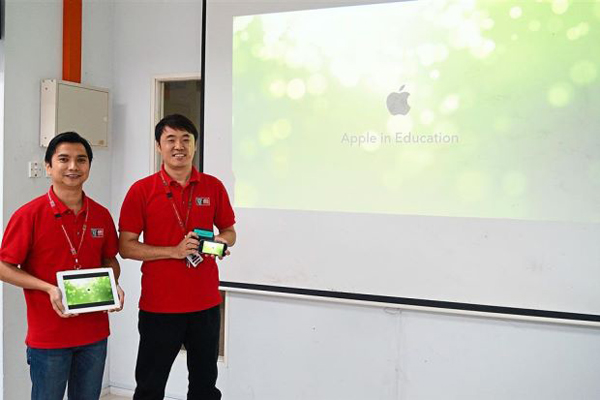KUCHING – Improving education in Sarawak is now possible by utilising smart technology to help in teaching and learning in the classroom.
Controlling devices or machines with a touch of a finger is no longer a futuristic vision with the introduction of smart phones, tablets and touch screen computers.
Also, printing of textbook and notes yearly has been regarded as less eco-friendly and inconvenient. School children are lugging huge bags with textbooks to school.
With this in mind, Apple Inc. has reinvented ways to teach using Ipad or tablets. They have envisioned a classroom setting whereby interactions between teachers and students can be reciprocal and wireless through plugging in of a simple small television called the Apple TV into the projectors.
Swinburne University of Technology Sarawak campus lecturers, William Suai and John Hii, have taken on the challenge to introduce this advance multimedia technology to schools and learning institutes all over Sarawak. Being two of the five certified Apple education trainers in Malaysia, both have conducted multiple talks and workshops to principles, heads of schools and teachers since 2012.
Hii said they reached out to schools because they wanted to improve all the schools in Sarawak and also Sabah.
“When they start creating Apple, they already started to produce a whole series of teaching and learning tools to teach people how to use PC. They actually want to inspire and educate people,” explained Hii during an interview in Swinburne.
The usage of laptops or PCs have limitations as it is only controlled by teacher and movement is limited, killing the fun in classrooms. However, using tablets and smart phones, these limitations can be solved.
The Airplay is a wireless system that when a device is connected to a projector, it projects what is in tablets or smart phones on the screen. The students can interject into the screen from their seats with their own devices by typing in a code instead of using hard drives or thumb drives. Presentation or conducting lessons have never been so easy and hassle free.
“When we do something like this, we know the gap in education. Apple wants them to experience something newer and simple,” said Hii during the demonstration.
Sharing files, pictures or videos are also a click away. With Air-drop, a device will detect all surrounding devices. Teachers can drag and drop files to student’s or colleague’s devices no matter how big the file size.
SIRI, programmed in the device uses speech recognition to launch apps and complete tasks. Teachers’ can save tremendous time copying answers on boards when they can read out the answer and let the smart devices type it for them.
The iCloud synchronizes works done from one device to other devices. Whether it is browsing history, power point or keynotes, one can work on different devices on the same subject. It’s convenient on the go and corrections can be done anytime.
Another important element of revolutionising education is using iBook, an interactive digital book which contains multiple pictures, videos, music. Some objects in the textbook are 3D and can be touched or rotated by readers, a wonderful way of learning subjects like science or any subjects which requires imagination. Textbook can be transferred to iBook and updated accordingly, saving time and paper.
Advance lessons with virtual reality and motion sensors are possible with the Oculus Rift and Leap Motion. Explore a 360˚ degree view of an area, dissect virtual frogs and mice or evaluate the structure of skulls or molecules with this immerse virtual reality device mounted on the head or hovering on it.
“We can create creative content and software to actually impress the students. What this does is it enables teachers and students to operate according to the sensors, using fingers or advance movement,” said Hii. The leap motion is a good tool for training fine motor skills in younger children.
University Malaysia Sarawak has already started using leap motion for medical students to practice on. Considering the many possibilities, some Swinburne students had invented games and app using it.
“iTunes-U is an education hub for content and courses which is actually provided by well known university, colleges and schools for free. It’s a collection of pdf files, links to internet or pages, links to videos etc. We can also build our own course and share it with others,” said Wilson.
Teachers do not have to worry about distractions during classroom by using guided access where they can lock access to anywhere else other than the things that students are suppose to look at. The Nearpod joins sets of devices used by students and they can do exercise or draw their answers on the screen.


